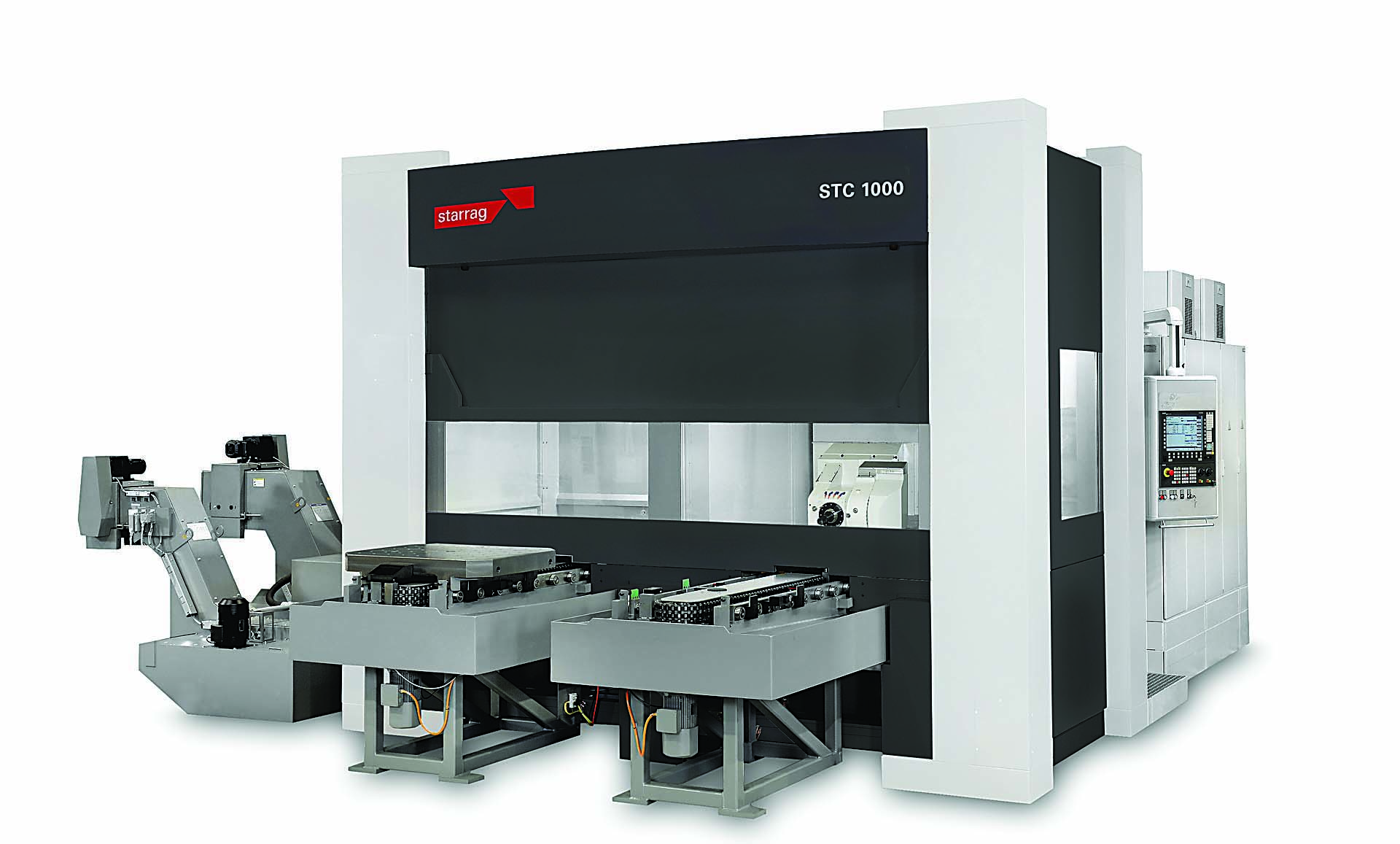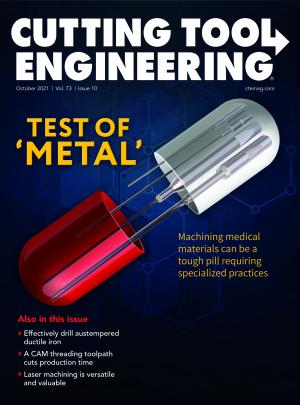Two vertical additions to a family of horizontal machining centers are designed for hard-metal machining of a variety of workpieces in the aerospace and energy industries.
The vertical machining centers, models MTV 1000 and MTV 1250 from Starrag USA Inc. in Hebron, Kentucky, are five-axis mill/turn machines offering single-setup milling, boring, drilling and tapping, as well as turning of materials, such as Ti6Al4V and Ti5553 titanium alloys, nickel-base superalloys and high-alloy steels. Capable of producing excellent surface finishes on complex and thin-wall parts, the machines are particularly well suited for aerospace engine casings and gearboxes, plus oil and gas applications, according to the company.
Delivering 1,627 Nm (1,200 ft.-lbs.) of torque, the MTV 1250 can process workpieces weighing up to 4,990 kg (11,000 lbs.) and measuring 2,388 mm (94") in diameter. Maximum travel along the x-, y- and z-axes is 2,184 mm (86"), 2,083 mm (82") and 1,880 mm (74"), respectively. The MTV 1000 offers 949 Nm (700 ft.-lbs.) of torque and can handle workpieces weighing up to 3,000 kg (6,613 lbs.) and measuring 1,880 mm in diameter. Travel along the x-, y- and z-axes is 1,702 mm (67"), 2,083 mm and 1,880 mm, respectively.

The MTV 1000 and MTV 1250 VMCs can handle both milling and turning of hard metals. Image courtesy of Starrag
High metal removal rates are possible with both machines thanks to an all-geared a-axis spindle drive. With minimal distance between the spindle nose and a-axis, the design allows the use of short tools and large bearings, providing high stability and rigidity compared with conventional motor spindles, according to Starrag.
“The a-axis is essentially a giant lever,” said Tim Mooney, director of sales for North America. “By keeping it short, you have maximum holding force at the tool tip because the lever effect is greatly decreased.”
The a-axis also features a steel worm gear. He said the toughness of steel gives this gear an advantage over conventional bronze gears, which loosen up over time when hard metals are cut. The gear offers active dampening for hard-metal machining, as well.
In addition, Mooney pointed out that the all-steel gear sets for the machine spindles are robust mechanical transmissions designed to take the forces generated when cutting hard metals, which provides them with a decided edge over electrospindle transmissions.
“We warranty the spindles on these machines for five years while the electrospindle warranty is typically one year,” he said.
Another key feature is a 30 hp angular automatic head, which allows access to internal surfaces and features. This head is loaded automatically from the tool magazine.
With an angular head available, the machines can cut both the inside and outside features of aerospace engine casings.
“We can load right-angle heads to mill or drill features inside a casing that are perpendicular to the spindle centerline without changing the part setup,” Mooney said. “So you can get to places that a traditional spindle cannot.”
For turning, the machines can deliver coolant at 207 bar (3,000 psi). Besides helping to ensure proper lubrication for a good surface finish, he said the high-pressure coolant is useful as a chipbreaker, preventing the formation of long stringer chips that are common in turning operations.
Both machines come with a Siemens 840D CNC. As is the case with other machines in the STC line, these VMCs are offered only with Siemens controls. Mooney allowed that this could be a downside for shops that are fans of controls from other companies.
Like other STC-MTV machines, the MTV 1000 and MTV 1250 can be used as stand-alone units or integrated into a cell or flexible manufacturing system. Integrated with other Starrag machines, they can use centralized tool handling and pallet storage. They also can be connected to additional processes, such as washing, deburring, part marking and coordinate measuring.
Mooney believes that the biggest challenge for the machines is composite machining but not because composites are hard to cut. Instead, the challenge is dealing with the dust produced when machining composites. The machines, for example, must be sealed properly so dust can’t enter and harm components like scales.
“It’s important that from the get-go, the materials to be cut are identified,” he said. “But the machines can be configured for virtually any application.”
Contact Details
Related Glossary Terms
- alloys
alloys
Substances having metallic properties and being composed of two or more chemical elements of which at least one is a metal.
- boring
boring
Enlarging a hole that already has been drilled or cored. Generally, it is an operation of truing the previously drilled hole with a single-point, lathe-type tool. Boring is essentially internal turning, in that usually a single-point cutting tool forms the internal shape. Some tools are available with two cutting edges to balance cutting forces.
- centers
centers
Cone-shaped pins that support a workpiece by one or two ends during machining. The centers fit into holes drilled in the workpiece ends. Centers that turn with the workpiece are called “live” centers; those that do not are called “dead” centers.
- chipbreaker
chipbreaker
Groove or other tool geometry that breaks chips into small fragments as they come off the workpiece. Designed to prevent chips from becoming so long that they are difficult to control, catch in turning parts and cause safety problems.
- composites
composites
Materials composed of different elements, with one element normally embedded in another, held together by a compatible binder.
- computer numerical control ( CNC)
computer numerical control ( CNC)
Microprocessor-based controller dedicated to a machine tool that permits the creation or modification of parts. Programmed numerical control activates the machine’s servos and spindle drives and controls the various machining operations. See DNC, direct numerical control; NC, numerical control.
- coolant
coolant
Fluid that reduces temperature buildup at the tool/workpiece interface during machining. Normally takes the form of a liquid such as soluble or chemical mixtures (semisynthetic, synthetic) but can be pressurized air or other gas. Because of water’s ability to absorb great quantities of heat, it is widely used as a coolant and vehicle for various cutting compounds, with the water-to-compound ratio varying with the machining task. See cutting fluid; semisynthetic cutting fluid; soluble-oil cutting fluid; synthetic cutting fluid.
- flexible manufacturing system ( FMS)
flexible manufacturing system ( FMS)
Automated manufacturing system designed to machine a variety of similar parts. System is designed to minimize production changeover time. Computers link machine tools with the workhandling system and peripherals. Also associated with machine tools grouped in cells for efficient production. See cell manufacturing.
- gang cutting ( milling)
gang cutting ( milling)
Machining with several cutters mounted on a single arbor, generally for simultaneous cutting.
- milling
milling
Machining operation in which metal or other material is removed by applying power to a rotating cutter. In vertical milling, the cutting tool is mounted vertically on the spindle. In horizontal milling, the cutting tool is mounted horizontally, either directly on the spindle or on an arbor. Horizontal milling is further broken down into conventional milling, where the cutter rotates opposite the direction of feed, or “up” into the workpiece; and climb milling, where the cutter rotates in the direction of feed, or “down” into the workpiece. Milling operations include plane or surface milling, endmilling, facemilling, angle milling, form milling and profiling.
- milling machine ( mill)
milling machine ( mill)
Runs endmills and arbor-mounted milling cutters. Features include a head with a spindle that drives the cutters; a column, knee and table that provide motion in the three Cartesian axes; and a base that supports the components and houses the cutting-fluid pump and reservoir. The work is mounted on the table and fed into the rotating cutter or endmill to accomplish the milling steps; vertical milling machines also feed endmills into the work by means of a spindle-mounted quill. Models range from small manual machines to big bed-type and duplex mills. All take one of three basic forms: vertical, horizontal or convertible horizontal/vertical. Vertical machines may be knee-type (the table is mounted on a knee that can be elevated) or bed-type (the table is securely supported and only moves horizontally). In general, horizontal machines are bigger and more powerful, while vertical machines are lighter but more versatile and easier to set up and operate.
- superalloys
superalloys
Tough, difficult-to-machine alloys; includes Hastelloy, Inconel and Monel. Many are nickel-base metals.
- tapping
tapping
Machining operation in which a tap, with teeth on its periphery, cuts internal threads in a predrilled hole having a smaller diameter than the tap diameter. Threads are formed by a combined rotary and axial-relative motion between tap and workpiece. See tap.
- turning
turning
Workpiece is held in a chuck, mounted on a face plate or secured between centers and rotated while a cutting tool, normally a single-point tool, is fed into it along its periphery or across its end or face. Takes the form of straight turning (cutting along the periphery of the workpiece); taper turning (creating a taper); step turning (turning different-size diameters on the same work); chamfering (beveling an edge or shoulder); facing (cutting on an end); turning threads (usually external but can be internal); roughing (high-volume metal removal); and finishing (final light cuts). Performed on lathes, turning centers, chucking machines, automatic screw machines and similar machines.



